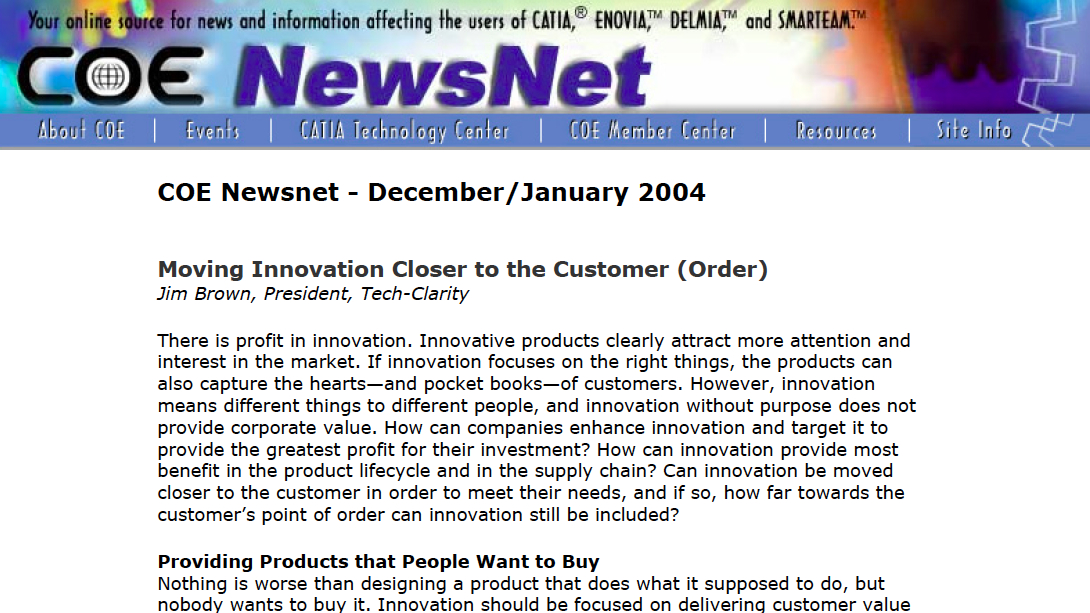A quick peek into some research on Social Business Collaboration and Advanced PPM. What do these two very interesting topics have in common? Live webcasts featuring Jim Brown of Tech-Clarity next week, Thursday and Friday February 16-17. OK, I admit it was a cheap trick, but I hope it convinces you to learn about one…
- Strategic Planning
- Executive Workshops
- Business Value Planning
- Advisory on Markets, Vendors, and Solutions
- Educational White Papers
- Surveys
- Speaking Engagements
- Webcasts
- Podcasts
- Vcasts, aka "Tech-Clarity TV"
Services for Software Vendors and Consultants 
Tech-Clarity helps software vendors and service companies by sharing our research, experience, and insights on the business value available from the intelligent use of enterprise software. Software vendors and service providers frequently invite Tech-Clarity to educate their customers and prospects on the business value of the solutions they offer, and benefit from clearer messages and more compelling descriptions of the value they offer.
Prospect and Customer Education
- Educational White Papers
- Surveys
- Speaking Engagements
- Webcasts
- Podcasts
- Vcasts, aka “Tech-Clarity TV”
- Case Studies
- Strategic Planning
- Product and Company Positioning
- Due Diligence for M&A
- Go to Market Strategies
- Product Roadmaps
- Website and Content Reviews, a “Second Set of Eyes”
- Marketing Checkup
Email Subscription 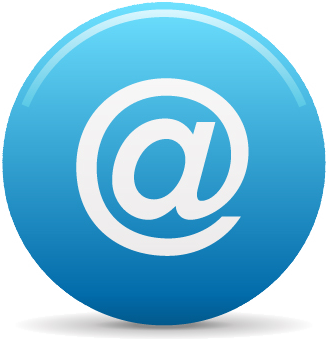
Enter your email to join our community, you will receive our newsletter and survey invitations.
Contact Us 
Contact Tech-Clarity using the form below.
[gravityform id="1" title="false" description="false" ajax="true"]
[post_title] => Contact
[post_excerpt] =>
[post_status] => publish
[comment_status] => closed
[ping_status] => closed
[post_password] =>
[post_name] => contact
[to_ping] =>
[pinged] =>
[post_modified] => 2024-03-05 20:50:54
[post_modified_gmt] => 2024-03-06 01:50:54
[post_content_filtered] =>
[post_parent] => 24
[guid] => http://tech-clarity.com.s123766.gridserver.com/?page_id=32
[menu_order] => 3
[post_type] => page
[post_mime_type] =>
[comment_count] => 0
[filter] => raw
)
[5] => WP_Post Object
(
[ID] => 27
[post_author] => 2
[post_date] => 2011-12-27 03:15:35
[post_date_gmt] => 2011-12-27 08:15:35
[post_content] =>

Jim Brown is the President of Digital Transformation Research for independent research firm Tech-Clarity. He covers digital transformation across the product digital thread for manufacturing and industrial companies including PLM, PDM, product development, portfolio management, digital manufacturing, IoT, EAM, SLM, and other solutions.
Jim founded Tech-Clarity in 2002 and has over 30 years of industry experience in the manufacturing and software industries. He began his career in manufacturing engineering and software systems at GE before pursuing management consulting at Andersen Consulting (Accenture). He subsequently served as a strategy, marketing, and product development executive for software companies specializing in ERP, PLM, Supply Chain, and related manufacturing solutions. He has a BS in Mechanical Engineering from the University of Maryland, College Park.
Jim is actively researching the impact of digital transformation and technology convergence in manufacturing. His research analyzes the business value available from new initiatives and technologies including cloud computing, advanced analytics, AI, product innovation platforms, service transformation, augmented reality, the digital twin, and the digital thread.
Mr. Brown is an experienced author and speaker and enjoys engaging with people with a passion to improve business performance through digital enterprise strategies and supporting software technology. When he’s not focused on technology, he is a scuba instructor and plays in an old guy ice hockey league.
[post_title] => Jim Brown [post_excerpt] => [post_status] => publish [comment_status] => closed [ping_status] => closed [post_password] => [post_name] => jim-brown [to_ping] => [pinged] => [post_modified] => 2024-10-03 12:57:39 [post_modified_gmt] => 2024-10-03 16:57:39 [post_content_filtered] => [post_parent] => 24 [guid] => http://tech-clarity.com.s123766.gridserver.com/?page_id=27 [menu_order] => -14 [post_type] => page [post_mime_type] => [comment_count] => 12 [filter] => raw ) [6] => WP_Post Object ( [ID] => 24 [post_author] => 2 [post_date] => 2011-12-27 03:14:32 [post_date_gmt] => 2011-12-27 08:14:32 [post_content] =>

Tech-Clarity is an independent research firm dedicated to making the business value of technology clear. We analyze how companies improve innovation, product development, design, engineering, manufacturing, and service performance through the use of digital transformation, best practices, software technology, industrial automation, and IT services.
Our mission is to help manufacturers learn how to improve business results through the use of PLM, portfolio management, CAD, simulation, MES / MOM, IoT, quality, service, analytics, and other solutions.
Meet Our Analysts






Disclosure
The views and opinions on this site are those of Tech-Clarity. The content is independent and objective, however, Tech-Clarity frequently receives compensation for reports and presentations in addition to consulting services. This compensation may influence the topics chosen for coverage but does not influence the views or opinions expressed. In addition, industry analysts including Tech-Clarity are frequently invited to attend conferences and briefings for which travel and reasonable living expenses are paid or reimbursed, in part or in full. Tech-Clarity does not accept compensation for posts or accept advertising on this site.
 Tech-Clarity Issue in Focus: Optimizing Product Portfolios with Advanced PPM: Applying Value Optimization to Portfolio Decision Making explains how companies can gain greater levels of product portfolio profitability by using value optimization techniques to make portfolio decisions. Describes how the basic best practices of PPM can be extended by Advanced PPM concepts.
Please enjoy the summary below, or click the report or title above to download the full PDF (free of charge, no registration required).
Tech-Clarity Issue in Focus: Optimizing Product Portfolios with Advanced PPM: Applying Value Optimization to Portfolio Decision Making explains how companies can gain greater levels of product portfolio profitability by using value optimization techniques to make portfolio decisions. Describes how the basic best practices of PPM can be extended by Advanced PPM concepts.
Please enjoy the summary below, or click the report or title above to download the full PDF (free of charge, no registration required).
Table of Contents
- Introducing the Issue
- The Basics of Product Portfolio Management
- The Next Level of Portfolio Decision Making
- Realizing Optimal Portfolio Value
- Conclusion
- Recommendations
- About the Author
Introducing the Issue
Companies are gaining significant business value by implementing Product Portfolio Management (PPM) best practices. According to Tech-Clarity’s Issue in Focus: The ROI of Product Portfolio Management, effective portfolio management can improve both top-line performance and bottom-line profitability. PPM does this by helping companies align their product portfolios with business objectives, effectively allocate resources to their projects, and better execute product development projects. Despite the value achieved from these standard PPM best practices, most companies fail to reach the highest possible levels of profitability because they lack a clear understanding of the potential financial value of the products in their portfolio. Part of the problem is that current best practices and technology lack an effective way to assess risk and uncertainty and can’t predict their impact on product value. These impacts can be in the range of millions of dollars. Decision-makers can’t afford to ignore this uncertainty, and can’t make optimal portfolio decisions without a realistic picture of the likely range of values returned from candidate projects in the portfolio. To get the most out of limited product development resources, companies need to be able to optimize the value of their product portfolios in addition to managing them through a product development processes with standard PPM best practices. Advanced PPM processes and technology enable this by providing a systematic approach to determine financial value. As Tech-Clarity’s Maximizing Product Development Value report concludes, “Creating high value portfolios is much simpler when the factors that create and destroy value for a project are clearly identified, quantified, and managed over the life of the project.” The result is extending “on-time” and “on-budget” to “on-profit.” With this understanding, companies can develop portfolios that provide an optimal financial return based on sound business analysis. [post_title] => Advanced PPM [post_excerpt] => [post_status] => publish [comment_status] => open [ping_status] => open [post_password] => [post_name] => advanced-ppm-wp [to_ping] => [pinged] => [post_modified] => 2022-11-14 22:27:30 [post_modified_gmt] => 2022-11-15 03:27:30 [post_content_filtered] => [post_parent] => 0 [guid] => http://tech-clarity.com/?p=2730 [menu_order] => 0 [post_type] => post [post_mime_type] => [comment_count] => 0 [filter] => raw ) [9] => WP_Post Object ( [ID] => 2677 [post_author] => 2 [post_date] => 2011-09-19 14:30:06 [post_date_gmt] => 2011-09-19 18:30:06 [post_content] => Issue in Focus: Systems and Software Driven Innovation - Complexity and Opportunity in the Mechatronic Era describes the fundamental shift to increased software and electronics in traditionally mechanical products, sometimes known as "mechatronics." The report explains the need to manage the resulting design complexity and how to take advantage of the opportunities offered by systems and software based products.
Please enjoy the summary below, or click the report or title to download a PDF overview of the report (free of charge, no registration required). Please visit the PTC website to download the full report (free of charge, no registration required).
Issue in Focus: Systems and Software Driven Innovation - Complexity and Opportunity in the Mechatronic Era describes the fundamental shift to increased software and electronics in traditionally mechanical products, sometimes known as "mechatronics." The report explains the need to manage the resulting design complexity and how to take advantage of the opportunities offered by systems and software based products.
Please enjoy the summary below, or click the report or title to download a PDF overview of the report (free of charge, no registration required). Please visit the PTC website to download the full report (free of charge, no registration required).
Table of Contents
- Introducing the Issue
- The Mechatronics Imperative
- The Complexity of Mechatronic Products
- Managing Change in Mechatronic Products
- Working Together – The Systems View
- The Opportunity to Innovate with Systems and Software
- Competing through Software Driven Innovation
- Enabling Software Driven Innovation
- PLM and Software Driven Innovation
- The Current Reality of PLM for Systems
- Conclusion
- Recommendations
- About the Author
Introducing the Issue
Modern products increasingly incorporate a combination of mechanical, electrical, and software components that allow innovative designers to take advantage of sensors and logic to solve problems and provide capabilities in new ways. This impacts the way companies innovate. As manufacturers develop their next generation of products, they are more likely to turn to electronics and software to make a “smarter” mousetrap as opposed to innovating solely in their mechanical design. Over the last decade, there has been a steady, fundamental shift towards increased software and electronics in traditionally mechanical products. Engineers have added more monitoring and more sophisticated controls, and have increased the amount of product functionality and value delivered through software as compared to mechanics. Examples of this shift range from automobiles, to mobile devices, to “simple” household appliances. This changing paradigm requires multiple design disciplines to work together to develop a working system. Systems that rely more heavily on the combination of mechanics, electronics, and software demand more integrated engineering and validation processes. The shift has driven higher levels of product development and engineering complexity starting in the early requirements phase of a product, continuing through design, making a significant impact on product testing and validation, and continuing as a configuration management issue throughout the product lifecycle. [post_title] => Systems and Software Driven Innovation [post_excerpt] => [post_status] => publish [comment_status] => open [ping_status] => open [post_password] => [post_name] => systems-sw-innovation [to_ping] => [pinged] => [post_modified] => 2022-11-14 22:27:29 [post_modified_gmt] => 2022-11-15 03:27:29 [post_content_filtered] => [post_parent] => 0 [guid] => http://tech-clarity.com/?p=2677 [menu_order] => 0 [post_type] => post [post_mime_type] => [comment_count] => 0 [filter] => raw ) [10] => WP_Post Object ( [ID] => 2659 [post_author] => 2 [post_date] => 2011-09-17 12:54:47 [post_date_gmt] => 2011-09-17 16:54:47 [post_content] => Issue in Focus: Enabling Mobile PLM - IT Considerations for Leveraging Mobility to Extend PLM Value points out some very practical considerations that IT leaders must take into account when taking PLM mobile. The rise of tablets like the iPad offers an opportunity to further PLM value by reducing barriers to innovation, decision-making, program management, and contribution to product development by extending applications to employees while they are away from the office. It also offers the potential to share critical manufacturing or service data to those in challenging locations such as the plant or in the field. See what the CIO should know about implementing and supporting mobile applications for PLM.
Please enjoy the Executive Summary below, or click the report title above to download a PDF that overviews the report (free of charge, no registration required). For the full report, visit the Siemens PLM website (free of charge, registration required).
Issue in Focus: Enabling Mobile PLM - IT Considerations for Leveraging Mobility to Extend PLM Value points out some very practical considerations that IT leaders must take into account when taking PLM mobile. The rise of tablets like the iPad offers an opportunity to further PLM value by reducing barriers to innovation, decision-making, program management, and contribution to product development by extending applications to employees while they are away from the office. It also offers the potential to share critical manufacturing or service data to those in challenging locations such as the plant or in the field. See what the CIO should know about implementing and supporting mobile applications for PLM.
Please enjoy the Executive Summary below, or click the report title above to download a PDF that overviews the report (free of charge, no registration required). For the full report, visit the Siemens PLM website (free of charge, registration required).
Table of Contents
- Introducing the Issue
- Leveraging Existing PLM Infrastructure
- Device Considerations
- Business Process Considerations
- Application Considerations
- People Considerations
- Management Considerations
- Conclusion
- Recommendations
- About the Author
- Analyzing and executing engineering changes
- Providing interactive, 3D manufacturing and service instructions
- Managing program status, issues, resources, and tasks
- Approving deliverables and signing off on stage-gate reviews
- Leveraging existing PLM infrastructure
- Device considerations
- Application considerations
- Process considerations
- People considerations
- Management considerations
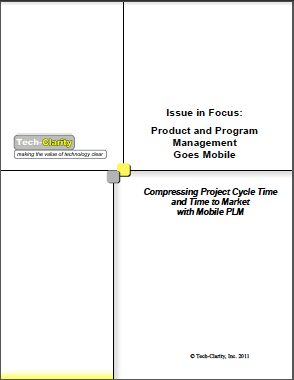 Issue in Focus: Product and Program Management Goes Mobile - Compressing Project Cycle Time and Time to Market with Mobile PLM describes how mobile workers can decide, approve, and contribute to their projects and programs in real-time using PLM in a mobile scenario. PLM applications provide significant value to product and program managers, including control of NPD processes and projects, better access to information, and improved decision making. But there are significant barriers that keep mobile employees from contributing to projects with PLM when they travel. Learn how mobile PLM applications can help.
Please enjoy the Executive Summary below, or click the report title above to download a PDF that overviews the report (free of charge, no registration required). For the full report, visit the Siemens PLM website (free of charge, registration required).
Issue in Focus: Product and Program Management Goes Mobile - Compressing Project Cycle Time and Time to Market with Mobile PLM describes how mobile workers can decide, approve, and contribute to their projects and programs in real-time using PLM in a mobile scenario. PLM applications provide significant value to product and program managers, including control of NPD processes and projects, better access to information, and improved decision making. But there are significant barriers that keep mobile employees from contributing to projects with PLM when they travel. Learn how mobile PLM applications can help.
Please enjoy the Executive Summary below, or click the report title above to download a PDF that overviews the report (free of charge, no registration required). For the full report, visit the Siemens PLM website (free of charge, registration required).
Table of Contents
- Introducing the Issue
- The Value of Mobility to Product and Program Management
- Compressing Project Cycle Time with Mobile PLM
- A Mobile Product and Program Management Scenario
- Conclusion
- Recommendations
- About the Author
Introducing the Issue
Manufacturers use Product Lifecycle Management (PLM) solutions to effectively control product, project, and programs across their enterprises and supply chains. These applications provide significant value to product and program managers, including control of NPD processes and projects, better access to information, and improved decision making. PLM helps companies manage the complexity of today’s projects and programs, including coordinating cross-functional teams that may be dispersed across different sites, time zones, and even company boundaries. This results in better planning and execution of projects, faster time to market, and reduced project risk. Unfortunately, there are significant barriers that keep mobile employees from contributing to projects with PLM when they travel. The challenges include inability to easily access information and being disconnected from processes. These barriers result in lag times in project execution and decision making that slow down project and program delivery. They may also contribute to people moving forward based on assumptions that will result in project rework or quality problems. The issue is that traditional devices that run PLM are simply not designed for mobility. Employees on the road or away from their desk may use smartphones to keep in touch via e-mail, but these devices lack the size and screen to be useful for most PLM applications. Laptops are helpful, but require users to be settled with a flat surface and their hands free. They are really designed for portability as opposed to mobility. Beyond devices, feature-rich project and program management software built for a desktop is not designed with mobile users in mind. Simply making desktop or web applications available on a mobile web browser can prove to be frustrating and cumbersome, resulting in people waiting for a more convenient time to contribute or handling issues outside of the system. Product and program managers can’t afford delays. They need mobile workers to decide, approve, and contribute to their projects and programs in real-time. Manufacturers can leverage the rise of tablets like the iPad to allow project leaders and team members alike to make decisions and keep their projects moving forward, regardless of their physical location and access to a PC. [post_title] => Product and Program Management Goes Mobile [post_excerpt] => [post_status] => publish [comment_status] => open [ping_status] => open [post_password] => [post_name] => pd-mobile [to_ping] => [pinged] => [post_modified] => 2022-11-14 22:27:27 [post_modified_gmt] => 2022-11-15 03:27:27 [post_content_filtered] => [post_parent] => 0 [guid] => http://tech-clarity.com/?p=2649 [menu_order] => 0 [post_type] => post [post_mime_type] => [comment_count] => 0 [filter] => raw ) [12] => WP_Post Object ( [ID] => 2640 [post_author] => 2 [post_date] => 2011-09-17 12:19:37 [post_date_gmt] => 2011-09-17 16:19:37 [post_content] =>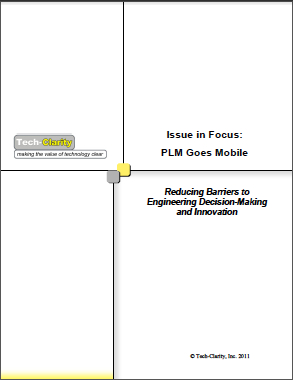 Issue in Focus: PLM Goes Mobile - Reducing Barriers to Engineering Decision-Making and Innovation explains how mobile devices like the iPad have set the stage to extend the ways engineers and others in the product lifecycle contribute, decide, act, and innovate with PLM. There are significant barriers to taking the value of PLM into the plant or into the service center – namely the available devices that run PLM. This means that much of the value of PLM gets left behind when an engineer leaves their workstation to get a firsthand view of production or see their products in the field. Find out how mobile applications and device in PLM can help.
Please enjoy the Executive Summary below, or click the report title above to download a PDF that overviews the report (free of charge, no registration required). For the full report, visit the Siemens PLM website (free of charge, registration required).
Issue in Focus: PLM Goes Mobile - Reducing Barriers to Engineering Decision-Making and Innovation explains how mobile devices like the iPad have set the stage to extend the ways engineers and others in the product lifecycle contribute, decide, act, and innovate with PLM. There are significant barriers to taking the value of PLM into the plant or into the service center – namely the available devices that run PLM. This means that much of the value of PLM gets left behind when an engineer leaves their workstation to get a firsthand view of production or see their products in the field. Find out how mobile applications and device in PLM can help.
Please enjoy the Executive Summary below, or click the report title above to download a PDF that overviews the report (free of charge, no registration required). For the full report, visit the Siemens PLM website (free of charge, registration required).
Table of Contents
- Introducing the Issue
- The Value of Mobility to Engineering
- Business Value of Mobile PLM Decision Making
- A Mobile Engineering Scenario
- Conclusion
- Recommendations
- About the Author
Introducing the Issue
Product Lifecycle Management (PLM) provides significant value to engineers and product developers, including control of product data, process management, and better access to information. PLM helps companies manage the increased complexity of today’s products and product development environments. As Tech-Clarity Insight: The Five Dimensions of Product Complexity states, “PLM solutions help manage the five dimensions of product complexity on an enterprise scale, resulting in greater efficiency and better products.” The result is increased innovation, higher revenue, decreased cost, and faster time to market. Today, however, there are significant barriers to taking the value of PLM into the plant or into the service center – namely the available devices that run PLM. This means that much of the value of PLM gets left behind when an engineer leaves their workstation to get a firsthand view of production or see their products in the field. This is also the case when a worker in the plant needs information and doesn’t have easy access to a terminal. There are further barriers for employees when they travel, according to Tech Clarity Issue in Focus: Product and Program Management Goes Mobile, resulting in lag times in decision making and project execution. The issue is the devices typically required to access PLM information and processes. Traditional choices for PLM have been laptops or workstations with bulky form factors, short battery life, and long boot times. Other choices include smartphones or netbooks, each with their own challenges. Beyond devices, software applications built for a personal computer or engineering workstation are simply not suited for the realities of mobile environments. Some things just don’t work on a smaller device but aren’t worth the overhead of booting up a laptop or struggling with a smartphone in a mobile environment. As a consequence, a lot of decision-making and innovation goes uncaptured or gets put on hold when an engineer is mobile. Manufacturers need to reduce the threshold to use PLM to extend the benefits beyond the desk. Otherwise, they might lose a brainstorm, or a technician might pass on an impulse to verify a detail that could have a large impact on product performance and profitability. Mobile devices like the iPad have set the stage to extend the opportunity for engineers and others in the product lifecycle to contribute, decide, act, and innovate with PLM. [post_title] => PLM Goes Mobile [post_excerpt] => [post_status] => publish [comment_status] => open [ping_status] => open [post_password] => [post_name] => plm-goes-mobile [to_ping] => [pinged] => [post_modified] => 2022-11-14 22:27:27 [post_modified_gmt] => 2022-11-15 03:27:27 [post_content_filtered] => [post_parent] => 0 [guid] => http://tech-clarity.com/?p=2640 [menu_order] => 0 [post_type] => post [post_mime_type] => [comment_count] => 0 [filter] => raw ) [13] => WP_Post Object ( [ID] => 2595 [post_author] => 2 [post_date] => 2011-09-13 10:15:04 [post_date_gmt] => 2011-09-13 14:15:04 [post_content] =>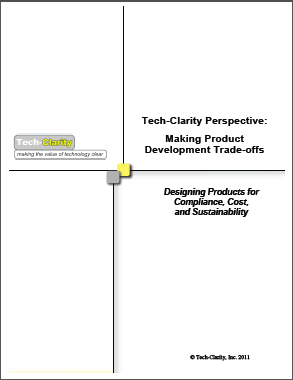 Tech-Clarity Perspective: Understanding Product Development Trade-offs - Designing Products for Compliance, Cost, and Sustainability presents results from a survey on how companies design their products to meet environmental regulatory compliance, product sustainability, and product cost targets. Shares survey data and perspectives from two leading manufacturers on how they collect data and manage the trade-offs between these important design criteria.
Please enjoy the Executive Summary below, or click the report title above to download the full PDF (free of charge, no registration required).
Feel free to watch the Related Webcast sponsored by PTC (free of charge, registration required).
Tech-Clarity Perspective: Understanding Product Development Trade-offs - Designing Products for Compliance, Cost, and Sustainability presents results from a survey on how companies design their products to meet environmental regulatory compliance, product sustainability, and product cost targets. Shares survey data and perspectives from two leading manufacturers on how they collect data and manage the trade-offs between these important design criteria.
Please enjoy the Executive Summary below, or click the report title above to download the full PDF (free of charge, no registration required).
Feel free to watch the Related Webcast sponsored by PTC (free of charge, registration required).
Table of Contents
- Executive Overview
- The Product Development Balancing Act
- Barriers and Challenges
- Design for Environmental Compliance
- Design for Sustainability
- Design for Cost
- Enabling Optimal Design Decisions
- Enabling Efficient and Effective Data Collection
- Conclusion
- Recommendations
- About the Research
- About the Author
Executive Overview
Over the last five to ten years, product environmental compliance has become increasingly critical to protecting top line revenue. Now, manufacturers also face emerging sustainability requirements stemming from corporate “green” initiatives, market pressure, scrutiny from NGOs like Greenpeace, emerging customer mandates, and even financial pressure from investors and sources like the Dow Jones Sustainability Index. To remain profitable, companies have to address compliance and sustainability while minimizing the impact on product cost. “We can’t sell a product if it’s not compliant so cost doesn’t enter into the equation for regulatory compliance. Since we are in a business that needs to remain viable, we must thoroughly investigate and assess our voluntary green initiatives with regards to impact to cost in other areas,” explains Kim Braun, an Environmental Compliance Engineer for Microsoft. Engineers and product developers have to address all of these criteria – compliance, cost, and sustainability – early in the product lifecycle when changes can still be made. Unfortunately, these are not independent criteria. Changes to one aspect can have a dramatic impact on the others. Similar to a juggler spinning plates, product developers have to focus on all aspects at once or they may all come crashing down. To address this, leading companies are building compliance, cost, and sustainability analysis into their design processes. “We try hard to embed it in design excellence and not make it a separate process,” explains the leader of corporate environmental compliance for a leading consumer products company. To understand the challenges manufacturers face in designing products for environmental compliance, sustainability, and cost, Tech-Clarity surveyed over one hundred companies and interviewed two leading, global manufacturers. The research identified two major themes that hinder companies from optimizing designs:- Collecting the right data to make informed decisions
- Making the information readily available to product developers in time to make decisions
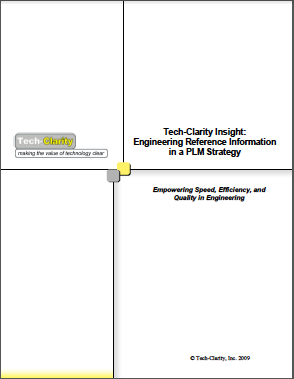 Tech-Clarity Insight: Engineering Reference Information in a PLM Strategy highlights the importance of efficiently providing engineering reference information to engineers in order to increase productivity. Describes how engineering information offers another tool in the PLM toolkit to improve design efficiency so engineers can spend more time on product innovation.
Please enjoy the Executive Summary below, or click the report title above to download the full PDF (free of charge, no registration required).
Note: Originally published in 2009
Tech-Clarity Insight: Engineering Reference Information in a PLM Strategy highlights the importance of efficiently providing engineering reference information to engineers in order to increase productivity. Describes how engineering information offers another tool in the PLM toolkit to improve design efficiency so engineers can spend more time on product innovation.
Please enjoy the Executive Summary below, or click the report title above to download the full PDF (free of charge, no registration required).
Note: Originally published in 2009
Table of Contents
- Executive Overview
- Just the Answer I Need Please
- Building Reference Information into the Engineering Workflow
- Strategic Benefit: Efficiency
- Mitigating Corporate Risk
- Financial Justification: Cost
- Conclusion
- Recommendations
- About the Author
- References and Notes
Executive Overview
Manufacturers today compete on speed and innovation to drive product profitability and profitable growth. These companies have recently given a lot of attention to business process improvement, organizational design, and enabling software technology to improve engineering productivity. Little executive attention has been placed, however, on the importance of providing efficient access to engineering reference information. Streamlined, electronic access to engineering information is another tool in the Product Lifecycle Management (PLM) toolkit that improves design efficiency so engineers can spend more time on innovation, create more new intellectual property, and accelerate time to market to capture market share and margin advantages. “Engineering reference information is an enabler,” says Spyro Kotsonis, EMS Global Mechanical Métier Manager at Schlumberger. “Engineering is made easier, more streamlined, and efficient by using electronic engineering reference information.” In essence, PLM focuses on improving product innovation, product development, and engineering performance. Reference information can play a significant role in these improvements. Too frequently, an engineer will have to pull away from their design work to look up a critical specification, formula, or other piece of information. To reduce the impact of this disruption and improve efficiency, the information they need should be:- Readily available
- Easily retrieved from a myriad of available information
- Provided from trusted, validated, and current sources
- Provided in the context needed (units of measure, etc.)
- Integrated into the engineer’s daily workflow
- Easy to reference for added credibility and risk management
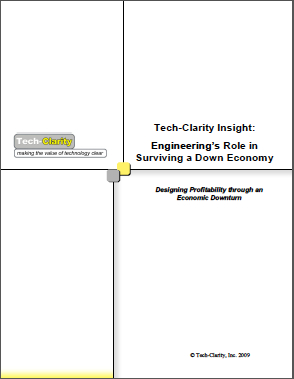 Tech-Clarity Insight: Engineering's Role in Surviving a Down Economy - Designing Profitability through an Economic Downturn discusses strategies that Engineering can adopt to help their companies navigate difficult financial times. Explains how Engineering can help their companies survive during the downturn, but also invest for the future to thrive during the eventual economic recovery.
Please enjoy the free Executive Summary below, or click the report title above to download the full PDF (free of charge, no registration required).
Note: Originally published in 2009
Tech-Clarity Insight: Engineering's Role in Surviving a Down Economy - Designing Profitability through an Economic Downturn discusses strategies that Engineering can adopt to help their companies navigate difficult financial times. Explains how Engineering can help their companies survive during the downturn, but also invest for the future to thrive during the eventual economic recovery.
Please enjoy the free Executive Summary below, or click the report title above to download the full PDF (free of charge, no registration required).
Note: Originally published in 2009
Table of Contents
- Executive Overview
- Holding the Top Line
- Delivering Customer Value at Reduced Cost
- Running a Lean Organization (as if you had a choice)
- Keeping an Optimistic Eye towards the Future
- Conclusion
- Recommendations
- About the Author
Executive Overview
Many manufacturers are feeling the impact of the global economic downturn. They are seeing already competitive, global markets tighten up and customer demand slipping. Revenues are falling, price points are weakening, and profits are sliding. To make matters worse, many Engineering departments are dealing with budget cuts, headcount freezes, early retirements, or even workforce reductions while still trying to develop the right products to keep the company competitive. Unfortunately, many of the product development challenges and inefficiencies they were already facing are brought further to the forefront as design capacity drops. Despite the urge to throw up their hands and give up, it is important for Engineering to recognize the role that they can play in keeping their company financially healthy in troubled economic times. There will surely be challenges and significant difficulty for many, particularly for those companies that must reduce the size of their workforce. Today, survival requires a combination of strategies and enabling technologies to help keep the business alive during the downturn, and ensure that it is in decent – if not very good – shape to take advantage of the eventual market turnaround. This paper is intended to provide guidance and insight to Engineers and Engineering Management as they develop their strategies for surviving the economic winter and preparing for the economic spring that will surely follow. These strategies include:- Pursuing product excellence to help sales hold the top line
- Implementing cost control to compete and save shrinking margins
- Investing for the future by continuing research and development and enhancing engineering capabilities
 Tech-Clarity Insight: Equipment Service Management: Maximizing Profit and Customer Value over the Equipment Lifecycle explains that there are two fundamentals that service organizations must master to rise above the competition - operational control of service operations and equipment intelligence. The paper also introduces an Equipment Service Management Framework that companies can use to benchmark their service processes and technology against a world class approach.
Please enjoy the free Executive Summary below, or click the report title above to download a PDF that overviews the report (free of charge, no registration required). For the full report, please visit the Lawson website (free of charge, registration required).
Note: This paper was originally published in 2008
Tech-Clarity Insight: Equipment Service Management: Maximizing Profit and Customer Value over the Equipment Lifecycle explains that there are two fundamentals that service organizations must master to rise above the competition - operational control of service operations and equipment intelligence. The paper also introduces an Equipment Service Management Framework that companies can use to benchmark their service processes and technology against a world class approach.
Please enjoy the free Executive Summary below, or click the report title above to download a PDF that overviews the report (free of charge, no registration required). For the full report, please visit the Lawson website (free of charge, registration required).
Note: This paper was originally published in 2008
Table of Contents
- Executive Overview
- Equipment Service Management: Opportunity and Challenge
- Stepping up to World Class Equipment Service Management
- Gaining Operational Control of Service
- Establishing Equipment Intelligence and Confidence in Service Knowledge
- Pulling it all Together for Proactive Service Management
- Pulling it all Together for Better Business Decisions
- The Equipment Service Management Framework
- Summary
- Recommendations
- About the Author
Executive Summary
Profitability and margins in equipment service are at risk due to current market dynamics. Increased competition and slim margins in equipment sales and rental place a heavy burden on manufacturers, dealers, rental companies and service businesses to improve their service performance. Improving service in these conditions is critical to maintaining margins and growing profitability. In order to compete effectively, this paper suggests that there are two fundamentals that service organizations must master to rise above the competition. These two fundamentals, operational control of service operations and equipment intelligence, enable companies to move to proactive service approaches and make better business decisions. To instill these two fundamentals, world class service organizations are adopting Equipment Service Management (ESM) processes and tools. This approach provides an integrated view to their business so they can improve the value their customers derive from their equipment and subsequently improve their own profitability. This paper introduces the “Equipment Service Management Framework” to help companies compare their organizations to best practices, and offers tangible suggestions to help them reach world class levels of service performance, resulting in greatly enhanced financial performance and profitable growth. [post_title] => Equipment Service Management [post_excerpt] => [post_status] => publish [comment_status] => open [ping_status] => open [post_password] => [post_name] => equipment-service [to_ping] => [pinged] => [post_modified] => 2022-11-14 22:27:24 [post_modified_gmt] => 2022-11-15 03:27:24 [post_content_filtered] => [post_parent] => 0 [guid] => http://tech-clarity.com/?p=2384 [menu_order] => 0 [post_type] => post [post_mime_type] => [comment_count] => 0 [filter] => raw ) [18] => WP_Post Object ( [ID] => 2378 [post_author] => 2 [post_date] => 2011-08-23 08:44:20 [post_date_gmt] => 2011-08-23 12:44:20 [post_content] =>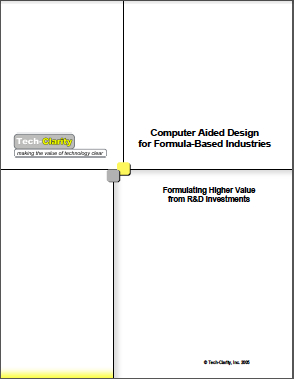 Computer Aided Design for Formula-Based Industries: Formulating Higher Value from R&D Investments outlines the business value achieved by Revlon, Shiseido / Zotos, Pfizer and other leading companies utilizing "CAD" software for formula-based product development, and provides guidance for similar manufacturers. While "CAD" is usually a term reserved for computer-aided design of physical / mechanical or electrical products, similar enablers are available for chemists, flavorists, and others involved in formulation.
Please enjoy the free Executive Summary below, or click the report title above to download the full PDF (free of charge, no registration required).
Note: Originally published in 2005
Computer Aided Design for Formula-Based Industries: Formulating Higher Value from R&D Investments outlines the business value achieved by Revlon, Shiseido / Zotos, Pfizer and other leading companies utilizing "CAD" software for formula-based product development, and provides guidance for similar manufacturers. While "CAD" is usually a term reserved for computer-aided design of physical / mechanical or electrical products, similar enablers are available for chemists, flavorists, and others involved in formulation.
Please enjoy the free Executive Summary below, or click the report title above to download the full PDF (free of charge, no registration required).
Note: Originally published in 2005
Table of Contents
- Executive Overview
- Why Computer Aided Design?
- Enabling the Chemist / Formulator
- Manipulating Formulas
- Documenting Findings – Digitizing the Lab Notebook
- Having the Right Information at Hand
- Enabling the R&D Team
- Sharing Information
- Managing the R&D Process
- Product Lifecycle Management – Profit from Innovation
- Collaborating Outside of R&D
- Protecting (and Leveraging) Intellectual Property
- Compliance
- CAD or PLM for Formulators?
- CAD and PLM for Formula-Based Industries
- Summary
- Recommendations
- About the Author
Executive Overview
Software applications have drastically improved the productivity of design engineers in many industries, allowing them to achieve designs that were previously not possible with manual, paper-based processes. Today’s complex products were simply not within the reach of engineers prior to the advent of software tools that relieved them of the labor intensive, time-consuming activities required to develop and validate their designs. Computer Aided Design (CAD) has played a large part in stretching the frontiers of modern products. When many people think of CAD they immediately think of Mechanical CAD (MCAD). Today’s advanced computer chips, however, could not have been realized without Electrical CAD (ECAD) software that enables chip designers to focus on innovative designs instead of manually trudging through hundreds of time-consuming steps. The essence of CAD is to provide a “digital design environment” in which engineers can rapidly develop, iterate and improve designs while reducing the manual effort that creates a barrier to product innovation. Without the advantages of CAD tools implemented over the last decade, the current market leaders in the automotive, aerospace and electronics industries would find themselves at a severe competitive disadvantage in today’s market. If CAD tools have enabled such great achievements in mechanical and electrical design, why haven’t formulators been relieved of their design burdens? There is certainly a lot of low value effort involved in developing a formula. Formulating chemists should maintain detailed documentation of their design and discovery process in order to protect intellectual property. They must review and take into account detailed information about target product characteristics, raw material specifications, ingredient interactions, ingredient ratios, premixes, wet and dry weights, usage restrictions and formula cost. More importantly, the formulator must be able to quickly iterate their designs in order to manage the trade-offs among cost, product performance, formula stability and regulatory requirements. To support this process, chemists are often forced to piece together spreadsheets and other “homegrown” tools to help solve their problems. Without relieving the R&D formulator of the burden of manual or suboptimal processes, innovation will continue to be hampered, products will be released at a slower pace, and companies will fail to deliver fully optimized product designs. If R&D staff can be relieved of their design overhead, they can develop more iterations in a shorter time— resulting in faster development cycles and significantly more valuable products. The parallel CAD tools for formula-based product development are beginning to gain broader acceptance. Tools for formula-based R&D have matured to a level that provides the equivalent value to what CAD provides in other disciplines, allowing the designer to innovate without consuming significant time performing burdensome “grunt work.” CAD, however, is not the only tool used in successful R&D environments. The value of CAD increases significantly when integrated with Product Lifecycle Management (PLM) applications. PLM extends product information and business processes beyond the individual designer, allowing them to both collaborate and to leverage product innovation for corporate profits. PLM tools can also provide an infrastructure for companies to seamlessly enable downstream processes that translate the designer’s ingenuity into profitable products. The success of CAD and PLM solutions in discrete industries such as Automotive and Electronics points towards significant value for formula-based industries, including Consumer Packaged Goods, Cosmetics, Pharmaceuticals, Food & Beverage, Specialty Chemicals and Paints. This paper outlines the results achieved by Revlon, Shiseido / Zotos, Pfizer and other leading companies that have utilized CAD software for formula-based product development, and provides guidance for similar manufacturers to achieve their R&D goals. Specifically, we review the success that these innovators have achieved, and highlight—via real life examples—the business value that CAD and PLM solutions can offer to formula-based industries across several key functions:- To the formulator, chemist or product developer, PLM-enabled CAD provides an automated, electronic lab notebook, a set of useful design tools, a tool to collaborate with others, and a powerful information-finding tool.
- To R&D management, PLM-enabled CAD is a productivity enhancer, a window to view overall R&D activities, and a way to make business rules visible so formulators consider them early in the design process.
- To corporate management, PLM-enabled CAD is a way to ensure compliance and better manage IP assets at the source of corporate value.
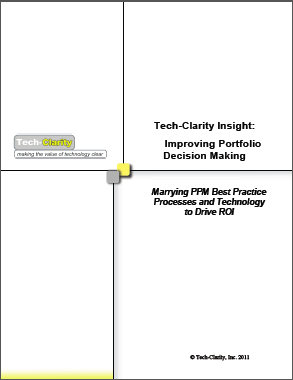 Tech-Clarity Insight: Improving Portfolio Decision-Making - Marrying PPM Best Practice Processes and Technology to Drive ROI describes the ability for Product Portfolio Management (PPM) initiatives to improve portfolio decision-making and ultimately company profitability. It explains how companies can take a practical approach to achieve the value of PPM by utilizing readily available best practice processes and metrics, leveraging the right software technology, and starting small to provide rapid value without a large, academic exercise.
Please enjoy the free Executive Summary below, or click the report title above to download the full PDF (free of charge, no registration required).
Table of Contents
Tech-Clarity Insight: Improving Portfolio Decision-Making - Marrying PPM Best Practice Processes and Technology to Drive ROI describes the ability for Product Portfolio Management (PPM) initiatives to improve portfolio decision-making and ultimately company profitability. It explains how companies can take a practical approach to achieve the value of PPM by utilizing readily available best practice processes and metrics, leveraging the right software technology, and starting small to provide rapid value without a large, academic exercise.
Please enjoy the free Executive Summary below, or click the report title above to download the full PDF (free of charge, no registration required).
Table of Contents
- Executive Overview
- The Purpose and Potential of PPM
- Applying Automation to PPM
- Putting Best Practice Processes to Work
- Taking the Practical Path to PPM
- Improving Portfolio Processes Over Time
- Conclusion
- Recommendations
- About the Author
All Results for "All"
Thank you!
Thank you! Thank you for your interest. You’ve successfully joined the Tech-Clarity mailing list.
Services for Manufacturing and Industry
Services for Manufacturing and Industry Tech-Clarity shares our research, experience and insights with manufacturers and other industry clients to educate them on the business value available from the intelligent use of enterprise software. Clients benefit by focusing on the value of solutions as opposed to the technology itself. Strategy and Advisory Services Strategic Planning Executive…
Services for Software Vendors and Consultants
Services for Software Vendors and Consultants Tech-Clarity helps software vendors and service companies by sharing our research, experience, and insights on the business value available from the intelligent use of enterprise software. Software vendors and service providers frequently invite Tech-Clarity to educate their customers and prospects on the business value of the solutions they offer,…
Contact
Email Subscription Enter your email to join our community, you will receive our newsletter and survey invitations. Contact Us Contact Tech-Clarity using the form below.
Jim Brown
Jim Brown is the President of Digital Transformation Research for independent research firm Tech-Clarity. He covers digital transformation across the product digital thread for manufacturing and industrial companies including PLM, PDM, product development, portfolio management, digital manufacturing, IoT, EAM, SLM, and other solutions. Jim founded Tech-Clarity in 2002 and has over 30 years of industry…
About
Tech-Clarity is an independent research firm dedicated to making the business value of technology clear. We analyze how companies improve innovation, product development, design, engineering, manufacturing, and service performance through the use of digital transformation, best practices, software technology, industrial automation, and IT services. Our mission is to help manufacturers learn how to improve business…
Advanced PPM
Tech-Clarity Issue in Focus: Optimizing Product Portfolios with Advanced PPM: Applying Value Optimization to Portfolio Decision Making explains how companies can gain greater levels of product portfolio profitability by using value optimization techniques to make portfolio decisions. Describes how the basic best practices of PPM can be extended by Advanced PPM concepts. Please enjoy the…
Systems and Software Driven Innovation
Issue in Focus: Systems and Software Driven Innovation – Complexity and Opportunity in the Mechatronic Era describes the fundamental shift to increased software and electronics in traditionally mechanical products, sometimes known as “mechatronics.” The report explains the need to manage the resulting design complexity and how to take advantage of the opportunities offered by systems…
Enabling Mobile PLM
Issue in Focus: Enabling Mobile PLM – IT Considerations for Leveraging Mobility to Extend PLM Value points out some very practical considerations that IT leaders must take into account when taking PLM mobile. The rise of tablets like the iPad offers an opportunity to further PLM value by reducing barriers to innovation, decision-making, program management,…
Product and Program Management Goes Mobile
Issue in Focus: Product and Program Management Goes Mobile – Compressing Project Cycle Time and Time to Market with Mobile PLM describes how mobile workers can decide, approve, and contribute to their projects and programs in real-time using PLM in a mobile scenario. PLM applications provide significant value to product and program managers, including control…
PLM Goes Mobile
Issue in Focus: PLM Goes Mobile – Reducing Barriers to Engineering Decision-Making and Innovation explains how mobile devices like the iPad have set the stage to extend the ways engineers and others in the product lifecycle contribute, decide, act, and innovate with PLM. There are significant barriers to taking the value of PLM into the…
Making Product Development Tradeoffs
Tech-Clarity Perspective: Understanding Product Development Trade-offs – Designing Products for Compliance, Cost, and Sustainability presents results from a survey on how companies design their products to meet environmental regulatory compliance, product sustainability, and product cost targets. Shares survey data and perspectives from two leading manufacturers on how they collect data and manage the trade-offs between…
Engineering Reference Information in a PLM Strategy
Tech-Clarity Insight: Engineering Reference Information in a PLM Strategy highlights the importance of efficiently providing engineering reference information to engineers in order to increase productivity. Describes how engineering information offers another tool in the PLM toolkit to improve design efficiency so engineers can spend more time on product innovation. Please enjoy the Executive Summary below,…
Engineering’s Role in Surviving a Down Economy
Tech-Clarity Insight: Engineering’s Role in Surviving a Down Economy – Designing Profitability through an Economic Downturn discusses strategies that Engineering can adopt to help their companies navigate difficult financial times. Explains how Engineering can help their companies survive during the downturn, but also invest for the future to thrive during the eventual economic recovery. Please…
Moving Innovation Closer to the Customer (Order)
This article, Moving Innovation Closer to the Customer (Order), was originally published in 2004 but I decided to include it in the current update of this site because it is still highly relevant today. Download the full article here (free of charge, no registration required).
Equipment Service Management
Tech-Clarity Insight: Equipment Service Management: Maximizing Profit and Customer Value over the Equipment Lifecycle explains that there are two fundamentals that service organizations must master to rise above the competition – operational control of service operations and equipment intelligence. The paper also introduces an Equipment Service Management Framework that companies can use to benchmark their…
Computer Aided Design for Formula-Based Industries
Computer Aided Design for Formula-Based Industries: Formulating Higher Value from R&D Investments outlines the business value achieved by Revlon, Shiseido / Zotos, Pfizer and other leading companies utilizing “CAD” software for formula-based product development, and provides guidance for similar manufacturers. While “CAD” is usually a term reserved for computer-aided design of physical / mechanical or…
Improving Portfolio Decision Making
Tech-Clarity Insight: Improving Portfolio Decision-Making – Marrying PPM Best Practice Processes and Technology to Drive ROI describes the ability for Product Portfolio Management (PPM) initiatives to improve portfolio decision-making and ultimately company profitability. It explains how companies can take a practical approach to achieve the value of PPM by utilizing readily available best practice processes…
